No.
The premise behind the article seems to be that SARS was widely prevalent (in some areas), >10% of people were infected, without severe symptoms, and developed antibodies that can now be tested for.
A 2006 systematic review looked at this:
Our meta-analysis, which included all identified studies except those on wild animal handlers, yielded an overall seroprevalence of 0·10% [95% confidence interval (CI) 0·02–0·18]. Health-care workers and others who had close contact with SARS patients had a slightly higher degree of seroconversion (0·23%, 95% CI 0·02–0·45) compared to healthy blood donors, others from the general community or non-SARS patients recruited from the health-care setting (0·16%, 95% CI 0–0·37).
This figure of 0.16% is in stark contrast to the claimed "tens of percent".
Although there are considerable variations in the seropositive estimates reported, it is clear that seroconversion is extremely rare among health-care workers, close contacts of SARS patients who did not develop the disease and members of the general population, including healthy individuals and non-SARS patients. This property of SARS-CoV, perhaps reflecting the evolutionary fitness of the virus, is in stark contrast to other common respiratory agents, most notably influenza where the usual ‘iceberg’ concept of disease applies. Instead the pattern of SARS infection in the community can paradoxically be represented as an inverted iceberg.

